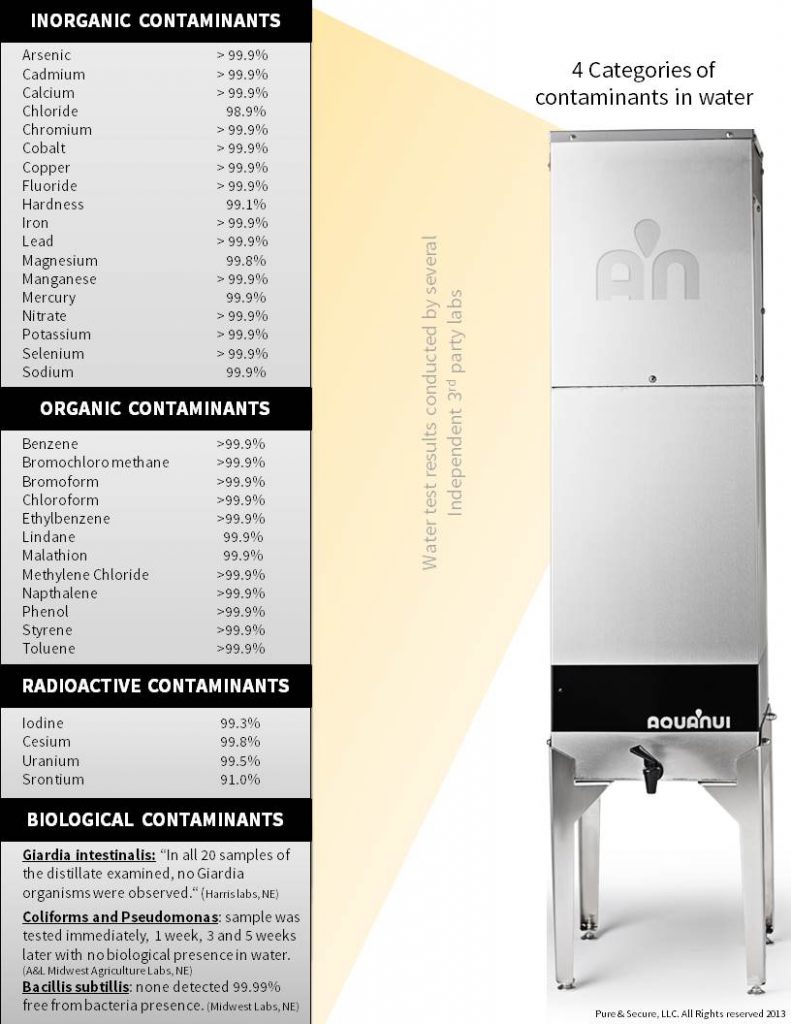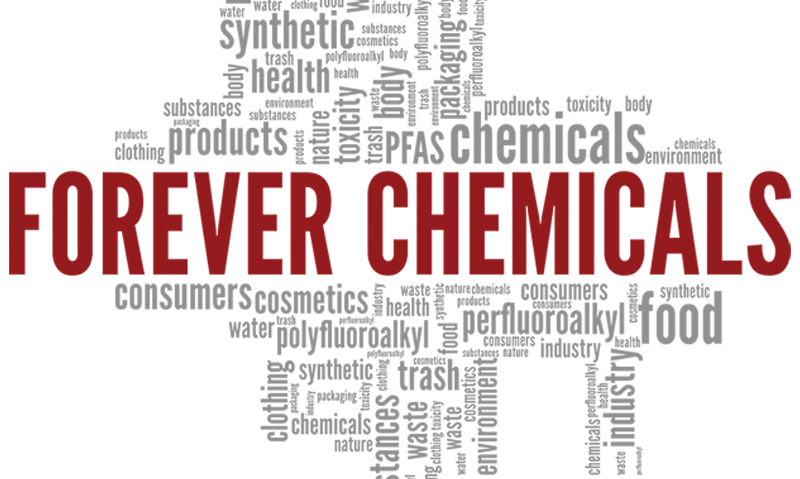What are PFAS?
Per- and polyfluoroalkyl substances (PFAS) are a large group of human-made chemicals that have been used in a wide range of industries since the 1940s. These chemicals are commonly found in products like non-stick cookware, water-repellent clothing, stain-resistant fabrics, firefighting foams, and various industrial processes. PFAS are characterized by their strong carbon-fluorine bonds, which make them resistant to heat, water, and oil. This durability has led to their widespread use, but it also means that PFAS are highly persistent in the environment and human body, earning them the nickname “forever chemicals.”
Does Distillation Remove PFAS?
Yes, distillation removes PFAS according to our Independent Lab Results. In fact, distillation remove much more than just PFAS.

Why Should You Be Concerned About PFAS?
Recent studies have shown that PFAS are present in the tap water of many communities across the United States, raising significant health concerns. The persistence and widespread nature of these chemicals mean that they can accumulate in the human body over time, leading to potential adverse health effects.
Health Effects of Ingesting PFAS
Research indicates that long-term exposure to PFAS can lead to several health problems. Some of the most concerning effects include:
- Cancer: Certain PFAS have been linked to an increased risk of cancers, such as kidney and testicular cancer.
- Hormonal Disruption: PFAS can interfere with the endocrine system, leading to thyroid disorders and other hormonal imbalances.
- Immune System Impacts: Exposure to PFAS may weaken the immune system, reducing the body’s ability to fight infections and potentially decreasing the effectiveness of vaccines.
- Developmental Issues: Prenatal exposure to PFAS has been associated with developmental delays in children, including low birth weight and developmental delays.
- Liver Damage: PFAS can cause liver damage, leading to altered liver enzyme levels and other liver-related issues.
- Cholesterol Levels: Studies have shown that PFAS can increase cholesterol levels, particularly LDL cholesterol, which is a risk factor for cardiovascular disease.
Recent Studies on PFAs
A study published in Environmental Science & Technology in 2020 found PFAS in the tap water of numerous major U.S. cities, affecting millions of people. Another study by the Environmental Working Group (EWG) in 2021 estimated that over 200 million Americans could have PFAS in their drinking water at concentrations exceeding the safe levels proposed by the Environmental Protection Agency (EPA). These findings underscore the pervasive nature of PFAS contamination and the urgent need for effective mitigation strategies.
What is the US Government Doing Regarding PFAS?
The U.S. government has recognized the significant public health threat posed by PFAS and has taken several steps to address the issue.
Regulatory Actions
- EPA’s PFAS Action Plan: In 2019, the EPA released its PFAS Action Plan, which outlines a comprehensive approach to addressing PFAS contamination. This includes developing drinking water standards for two of the most studied PFAS, PFOA and PFOS, and expanding research on PFAS.
- Proposed Drinking Water Standards: In March 2021, the EPA announced proposed regulatory determinations to set enforceable drinking water limits for PFOA and PFOS, aiming to reduce their levels in public water systems.
- Toxic Release Inventory (TRI): The EPA has added certain PFAs to the TRI, requiring companies to report their releases of these chemicals, thus increasing transparency and helping to track and manage PFAS contamination.
- Defense Department Initiatives: The Department of Defense has initiated efforts to identify and remediate PFAS contamination at military sites, as PFAS are commonly found in firefighting foams used by the military.
Legislative Actions
- PFAS Action Act: In 2021, the House of Representatives passed the PFAs Action Act, which aims to regulate PFAs as hazardous substances, set drinking water standards, and provide funding for water treatment and remediation efforts.
- National Defense Authorization Act (NDAA): Recent iterations of the NDAA have included provisions to address PFAs contamination, such as banning PFAS-containing firefighting foams and requiring the military to phase out their use.
How to Remove PFAS from Drinking Water?
Given the health risks associated with PFAS, it makes sense to find effective methods to remove these chemicals from drinking water. Several water purification methods can reduce PFAS levels, with varying degrees of effectiveness.
Distillation: The Gold Standard of Water Purification
AquaNui Water Distillers
Made in the U.S.A.
Distillation is the most effective method for removing PFAS from drinking water. This process involves heating water to create steam, which is then condensed back into liquid form, leaving contaminants like PFAS behind. Since PFAS have a much higher boiling point than water, they do not evaporate and are thus effectively separated from the purified water. Distillation can remove over 99.9% of PFAS, making it a highly reliable option for ensuring safe drinking water. Remove known and unknown contaminants from your drinking water with the use of an AquaNui home water distiller.
Activated Carbon Filtration
This method uses activated carbon to adsorb PFAS from water. While somewhat effective for certain PFAS, particularly long-chain PFAS like PFOA and PFOS, it may not be as efficient for shorter-chain PFAS.
Reverse Osmosis
Reverse osmosis systems force water through a semi-permeable membrane, which can effectively remove many contaminants, including PFAS. However, the efficiency of PFAS removal can vary based on the membrane’s properties and the specific PFAs present, so it is not as trustworthy as distillation.
Ion Exchange Resins
These resins can be used to remove PFAS from water by exchanging ions with the PFAS molecules. This method can be effective, but it requires diligent maintenance and replacement of the resins.
Forever Chemicals
PFAS, or “forever chemicals,” are a group of synthetic substances that have found their way into tap water, raising significant health concerns. Long-term exposure to PFAS is linked to various adverse health effects, including cancer, hormonal disruption, and developmental issues. Recent studies have highlighted the widespread nature of PFAS contamination in the U.S., prompting government action at both regulatory and legislative levels.
Efforts to mitigate PFAS contamination include setting drinking water standards, increasing transparency through reporting requirements, and funding remediation efforts. While some of the above methods can reduce PFAS levels, it is important to note that not all home water purification systems are equally effective. Wise consumers do their research and choose systems that will effectively remove PFAS and follow manufacturer guidelines for maintenance and replacement of filters. On an individual level distillation can help you take control of your drinking water and ensure it’s safety.

